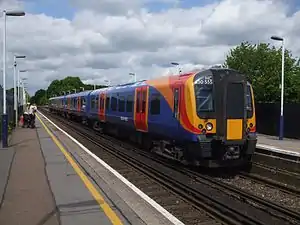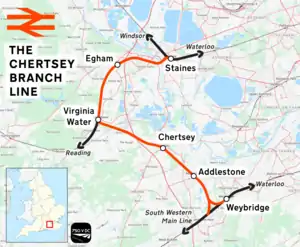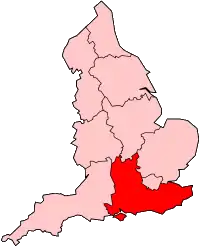Chertsey branch line
The Chertsey branch line, opened in 1848, connects the Waterloo to Reading Line at Virginia Water to the South Western Main Line at Weybridge. It is also referred to as the Weybridge branch line, or by its more accurate description since 1866, the Chertsey loop. For passenger services it has a terminus siding at Weybridge otherwise its other three stations are through stations and serve the modest-population settlements Chertsey, Addlestone and Virginia Water. Day trip steam excursions share in use of the line sometimes calling at London Waterloo, Staines, Woking and stations and others before Salisbury, Yeovil, Dorchester and/or Bath towards the far south-west of the country.
| Chertsey branch / Chertsey loop line | |||
|---|---|---|---|
 South West Trains Class 450 at Addlestone in 2009 | |||
| Overview | |||
| Status | Operational | ||
| Owner | Network Rail | ||
| Locale | Surrey, South East England | ||
| Stations | 4 | ||
| Service | |||
| Type | Suburban rail, Heavy rail | ||
| System | National Rail | ||
| Operator(s) | South Western Railway | ||
| History | |||
| Opened | 1849 | ||
| Technical | |||
| Line length | 5.5 miles (8.9 km) | ||
| Number of tracks | 2 | ||
| Track gauge | 1,435 mm (4 ft 8 1⁄2 in) standard gauge | ||
| Electrification | Yes | ||
| |||
Chertsey branch line | |||||||||||||||||||||||||||||||||||||||||||||||||||||||||||||||||||||||||||||||||||||||||||||||||||||||||||||||||||||||||||
|---|---|---|---|---|---|---|---|---|---|---|---|---|---|---|---|---|---|---|---|---|---|---|---|---|---|---|---|---|---|---|---|---|---|---|---|---|---|---|---|---|---|---|---|---|---|---|---|---|---|---|---|---|---|---|---|---|---|---|---|---|---|---|---|---|---|---|---|---|---|---|---|---|---|---|---|---|---|---|---|---|---|---|---|---|---|---|---|---|---|---|---|---|---|---|---|---|---|---|---|---|---|---|---|---|---|---|---|---|---|---|---|---|---|---|---|---|---|---|---|---|---|---|---|
| |||||||||||||||||||||||||||||||||||||||||||||||||||||||||||||||||||||||||||||||||||||||||||||||||||||||||||||||||||||||||||
History
On 16 July 1846, the London and South Western Railway (LSWR) was authorised to construct a railway line from Weybridge to Egham, close to Staines Bridge. This was opened as far as Chertsey on 14 February 1848.[1] The planned section beyond was not built by the LSWR, because a different company – the Windsor, Staines and South Western Railway (WS&SWR) – was authorised on 25 June 1847 to build a line from Staines to Pirbright and a branch from that line to Chertsey, where it would connect with the LSWR branch from Weybridge. The WS&SWR line was not built, and the powers expired.[2]
On 23 June 1864, the LSWR was authorised to construct an extension 2 1⁄2 miles (4.0 km) long from Chertsey to meet the Staines, Wokingham and Windsor Junction Railway (SW&WJR) at Virginia Water, and this line opened on 1 October 1866.[3] The line was double-track, and at its northern end there was a single-track spur facing Reading; this spur was doubled on 4 August 1897.[4]
The junction at the Weybridge end was also made triangular: the new curve was authorised on 20 August 1883, and opened on 10 August 1885; it was not regularly used until 4 July 1887. The junction of this curve with the down line near Byfleet was altered to a burrowing junction from 19 February 1903.[4]
The spur at Virginia Water giving access from Chertsey towards Ascot was closed in 1966.
The line was electrified (660 V DC third rail) on 3 January 1937 by the Southern Railway.[5]
Demand and population more especially have grown around the two stations exclusively on the line. In 2014–2015 financial years journeys made from or to Chertsey and Addlestone totalled 0.995 million. Being a loop and for tourist services and goods services being a corollary to the South West Main Line, the line many use restrictions, the main barrier being three road level crossings in central urban Egham which have elicited strong opposition by way of petitions to prevent any proposed increased obstruction by trains, see Heathrow Airtrack which produced detailed, abandoned, plans for direct southward Heathrow connections by rail.
Services
On Mondays to Saturdays, a half-hourly all-stations service to London Waterloo runs via Staines and the Hounslow Loop Line. Travel time may be shortened by a few minutes by changing to a fast train at Staines or Weybridge. On Sundays there is an hourly all-stations service which, instead of going to Weybridge, takes the west curve at Byfleet Junction and terminates at Woking. That curve is little used although from 2000 to 2002 the London Crosslink service of Anglia Railways from Colchester and Ipswich to Basingstoke via north London and Staines, which used Class 170 DMUs, took it.
Rolling stock
Trains are generally operated by British Rail Class 707, but some British Rail Class 458 units work the line too.
Lyne railway bridge
.jpg.webp)
Between Virginia Water and Chertsey, the line crosses the M25 motorway by means of a cable-stayed bridge. The bridge is of note because it is one of few such bridges to carry a heavy railway required here as the railway approaches the motorway at an angle of 28 degrees. The bridge consists of two concrete towers set into the central reservation of the motorway. The concrete edge beams are suspended from the towers, and each is supported by a pair of cables linked to the towers. The edge beams support a concrete deck slab on which the tracks run. The bridge is 120 yards (110 metres) long and 72 feet (22 metres) high and was completed in 1979.[6]
References
- Williams, R.A. (1968). The London & South Western Railway, volume 1: The Formative Years. Newton Abbot: David & Charles. pp. 180–1. ISBN 0-7153-4188-X.
- Williams 1968, p. 181
- Williams, R.A. (1973). The London & South Western Railway, volume 2: Growth and Consolidation. Newton Abbot: David & Charles. p. 67. ISBN 0-7153-5940-1.
- Williams 1973, p. 68
- Moody, G.T. (May 1958) [1957]. Southern Electric (2nd ed.). Hampton Court: Ian Allan. p. 65. 786/262/100/558.
- "Lyne Bridge, Chertsey – Railway Structures". Southern E-Group. Retrieved 30 August 2013.

